Microsoft Teams Statistics By Users, Downloads, Revenue and Facts
Updated · Feb 26, 2025
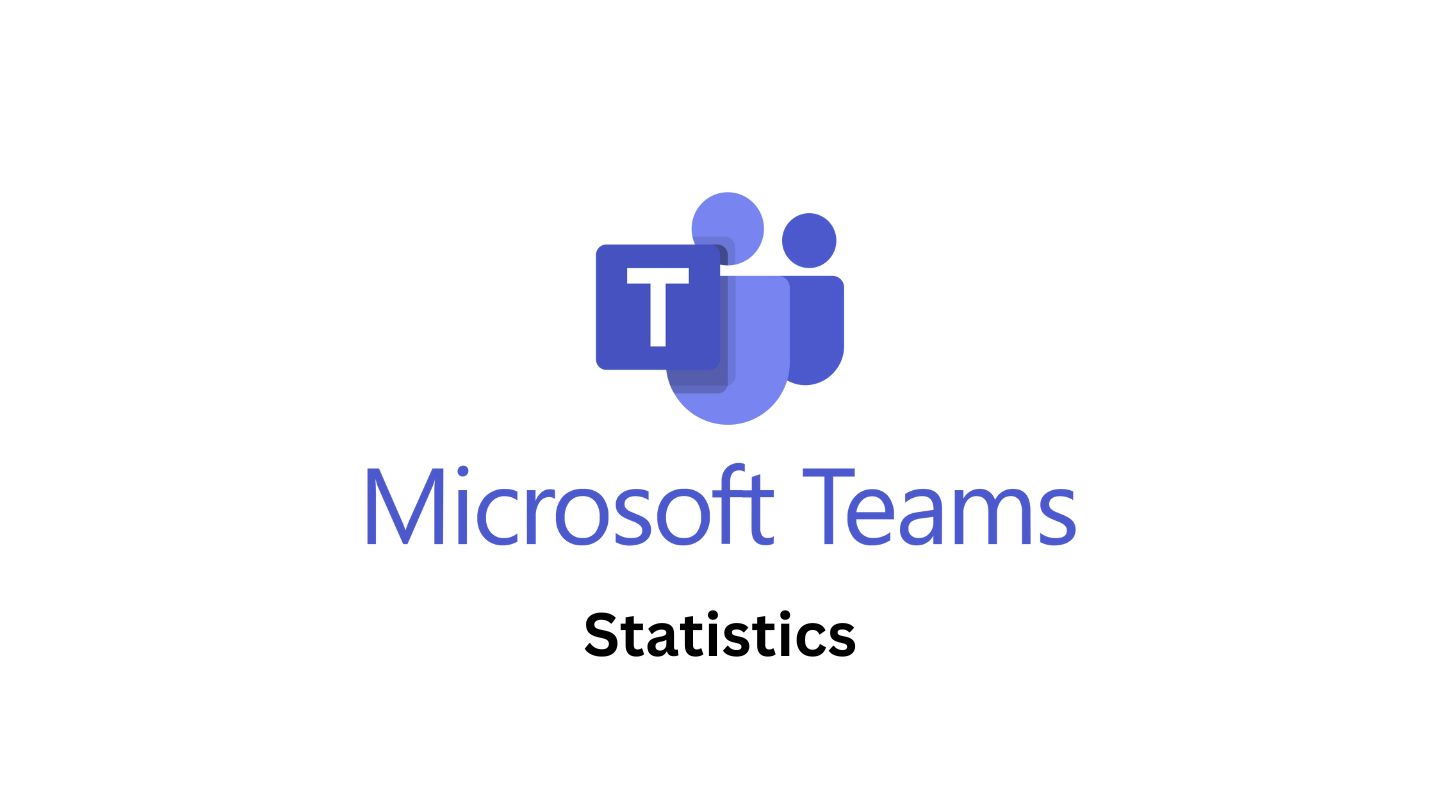
Table of Contents
- Introduction
- Editor’s Choice
- Microsoft Teams mobile app global downloads
- Microsoft Teams Active Users
- Microsoft Teams Revenue
- Microsoft Teams Users By Country
- Industries Using Microsoft Teams
- Microsoft Team User Demographics
- Microsoft Teams Adoption Statistics
- Microsoft Teams Meeting Breakdown
- Teams In Commercial, Education and Organizations
- Microsoft Teams Market Share
- Conclusion
Introduction
Microsoft Teams Statistics: Microsoft Teams is a highly visible and highly transformative part of rapidly evolving digital collaboration systems. This article reflects the changes that were brought to the lives of people, organizations, schools, and many other entities worldwide with its introduction in 2017 and phenomenal growth to truly become part of the everyday operations for people today.
The article further looks into the all-comprehensive Microsoft Teams statistics, hence looking at its user base, revenue generation, market share, demographic insights, and efforts in sustainable development.
Editor’s Choice
- According to Microsoft Teams statistics, Microsoft Teams has about 320 million daily active users as of 2024, with a consistent increase since the COVID-19 pandemic.
- The joining of such a platform is crucial in the Microsoft 365 suite, initiated in 2017, but eventually made necessary by businesses, schools, and organizations.
- According to the early 2020 pandemic, European, Middle Eastern and African mobile app downloads of Microsoft Teams increased by up to 750%.
- Videoconferencing is so entrenched in the culture of work that US professionals spend more than 10 hours a week in meetings.
- Microsoft Teams statistics reveal that Microsoft Teams has increased revenues tremendously from US $10 million in 2017 to over US $8 billion in 2023, with a significant surge in 2020 caused by the pandemic.
- Herein, the USA shows the highest records in terms of Microsoft Teams, with 8 million companies adopting the platform, followed by the UK (1.9 million), Canada (855,000), and Germany (285,000).
- The highest uptake is from IT (29.6%), with the next highest being Computer Software (11.8%), Healthcare (9.6%), and then Education making up 8.3%.
- Microsoft Teams statistics state that Microsoft Teams is used mostly by professionals aged between 35-44 (31.23%), followed by 45-54 (29.98%) and 55+ (20.82%).
- Every minute has added up to 1.875 million meeting minutes, which adds up to 2.7 billion minutes per day and 985.5 billion minutes per year.
- There are 100 million students on Microsoft Teams for education, but Microsoft makes less revenue per user for students as compared to commercial businesses.
- Microsoft Teams statistics show that Teams are widely adopted in big enterprises, with 117 firms having more than 100,000 users and 2,700 companies having more than 10,000 users.
- Zoom leads the video conferencing market with a share of 55.91%, followed by Microsoft Teams with a share of 32.29%.
Microsoft Teams mobile app global downloads
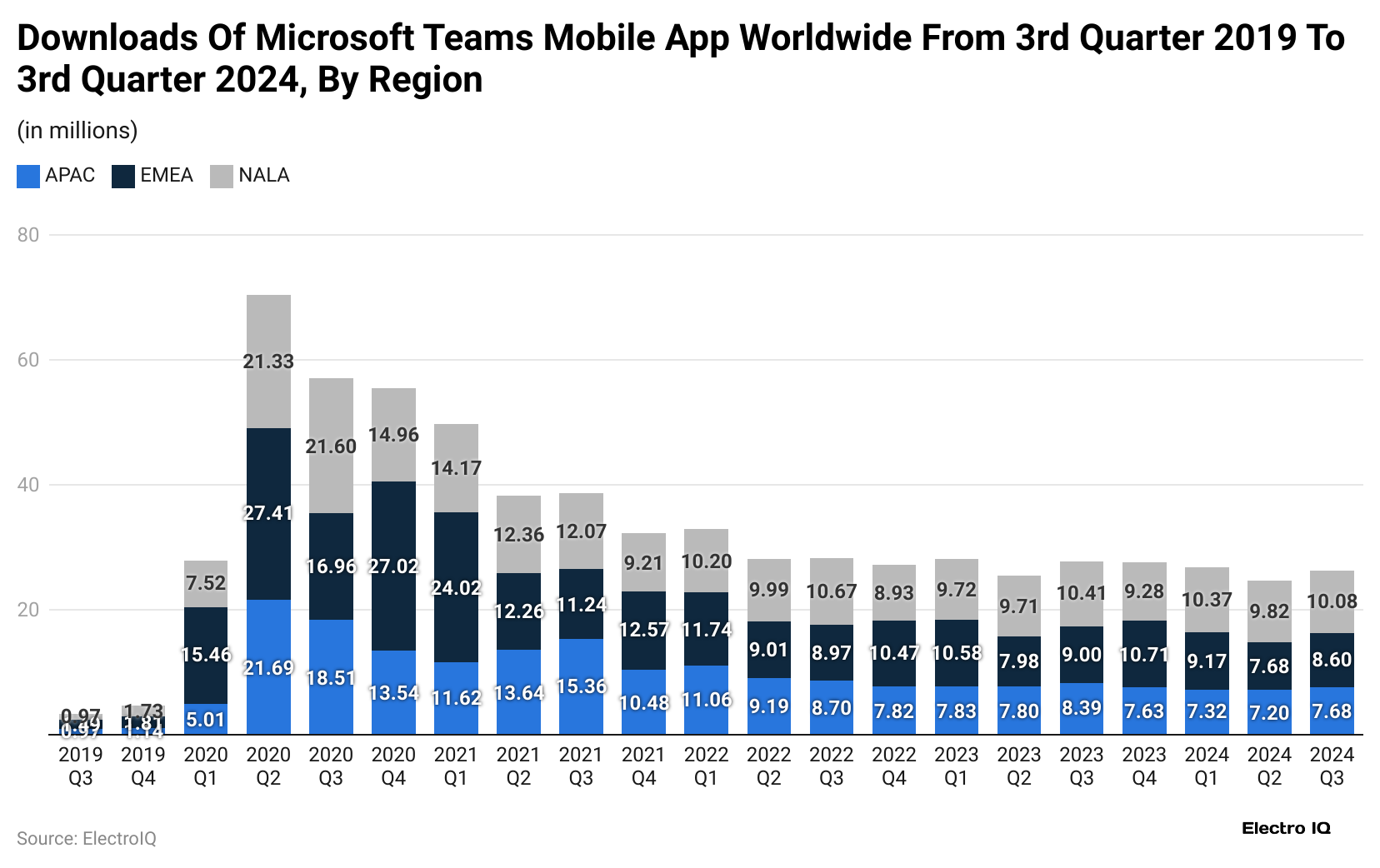 (Reference: statista.com)
(Reference: statista.com)
- Microsoft Teams statistics reveal that of the countries in the Middle East and Africa, Microsoft Teams proved to be the most popular download, amounting to almost 8.6 million during the time under investigation.
- Once again, from the start of 2020, that region had the highest figure in downloads from various countries reaching a staggering approximately 27.4 million in the second quarter of 2020.
- Conferring video conferencing platforms have permanently indentured modern working spaces as an embedded part of them.
- There is a study conducted in 2023 which shows that the people whom professionals cover in their daily meetings could be 10 hours and over in a week.
- The way of doing work has been tremendously changed because of the COVID-19 pandemic, where people minimised their interactions from face-to-face to the digital platform.
- It’s based on that growth because the most famous videoconferencing platforms like Microsoft Teams or Zoom jumped suddenly in downloads.
- From late 2019 to early 2020, the app for mobile devices with Microsoft Teams used by Europeans, Middle Easterners, and Africans grew by well over 750%. Though both apps were in much demand last year, Microsoft Teams and Zoom followed the same lines.
- It recorded 129 million downloads in the Asia-Pacific region alone during the second quarter of that year. End of 2019 zoom considered having around 10 million daily meeting participants. This number climbed to approximately 300 million in April 2020.
- It also increased to 20, then to 75 million users of teams who accessed them daily in 2020. By 2023, Microsoft Teams had well over 320 million active users using that platform, engaging daily.
- In January 2024, over three-quarters of the total number of all Internet users globally availed of email services each month.
- In America, people are very busy each day sending emails, with an estimated 10 billion daily emails being sent in the country in April 2024. It follows that Germany and Ireland are next in rank, having around 8.5 billion and 8.4 billion daily emails sent, respectively.
- It is also articulated that the projections regarding worldwide emails by 2027 would hover around 410 billion emails sent per day.
- Email services are now as such; Apple’s MPP has become the first, covering 55% of opened emails until March 2024, followed by Gmail with 30.57% and lastly, Outlook with 4.06. With the increasing involvement of artificial intelligence, even email writing becomes involved.
- Microsoft Teams statistics state that In March 2024, around 15% of American users said they use AI tools to generate emails, while about another 25% would in the future.
Microsoft Teams Active Users
 (Reference: statista.com)
(Reference: statista.com)
- Microsoft Teams statistics show that Team Microsoft has maintained around 320 million daily active users for the past year. In what we hath called the COVID-19 Pandemic”, usage saw an unprecedented blip due to more and more people working from home and practising social distancing norms.
- Microsoft Teams, a significant part of the Microsoft 365 Suite, was first introduced in July 2017; since then, it has come to be one of the major tools for communication and collaboration.
- Lockdowns during the pandemic implied that the internet recorded massive usage trends in the United States.
- Daily in-home data consumption recorded about 4.4 gigabytes higher than in the same period of 2019, indicating a jump of nearly 40% during March 2020.
- Huge data jumps were recorded from gaming consoles to smartphones, and almost any kind of device started witnessing a bump. During this time, social media, video streaming, and video conferencing tools were the most availed services in the U.S. market.
Microsoft Teams Revenue
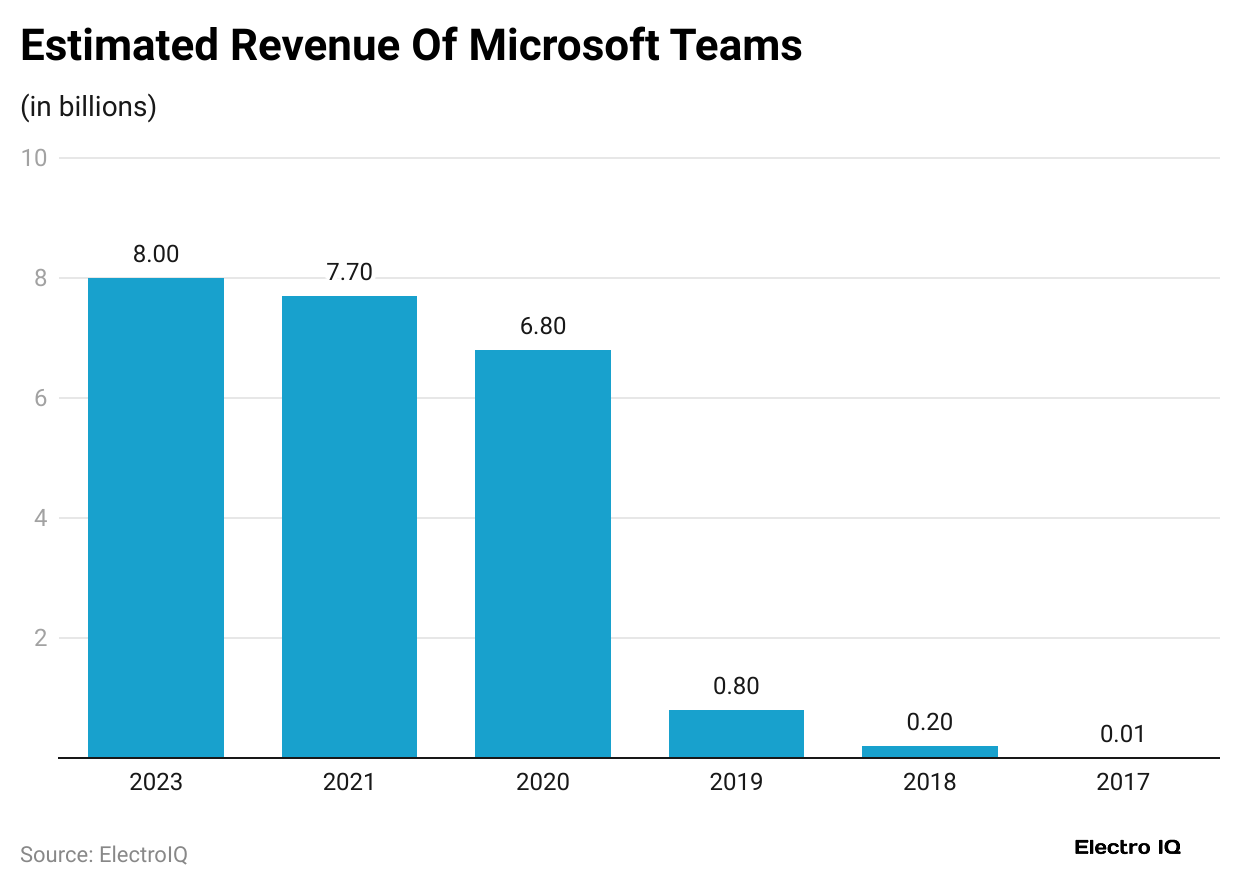
- Since it was launched in 2017, Microsoft Teams has shown rapid revenue growth.
- It recorded only US$10 million (0.01 billion) as revenue in its first year. In the following year, it started showing minor signs of adoption already when revenue soared by US$200 million (0.2 billion) by the end of 2018.
- For 2019, Teams made the most significant jump to hit US$800 million in revenues (0.8 billion). The next year, through the COVID-19 pandemic in 2020, revenues skyrocketed dramatically, with the platform making US$6.8 billion as more individuals and businesses turned to online collaborative tools for remote working.
- By 2021, it grew even bigger to US$7.7 billion and continuously expanding.
- Microsoft Teams statistics state that In 2023, Microsoft Teams surpassed the US$8 billion mark, making it one of the premier communication and collaboration platforms in the market.
Microsoft Teams Users By Country
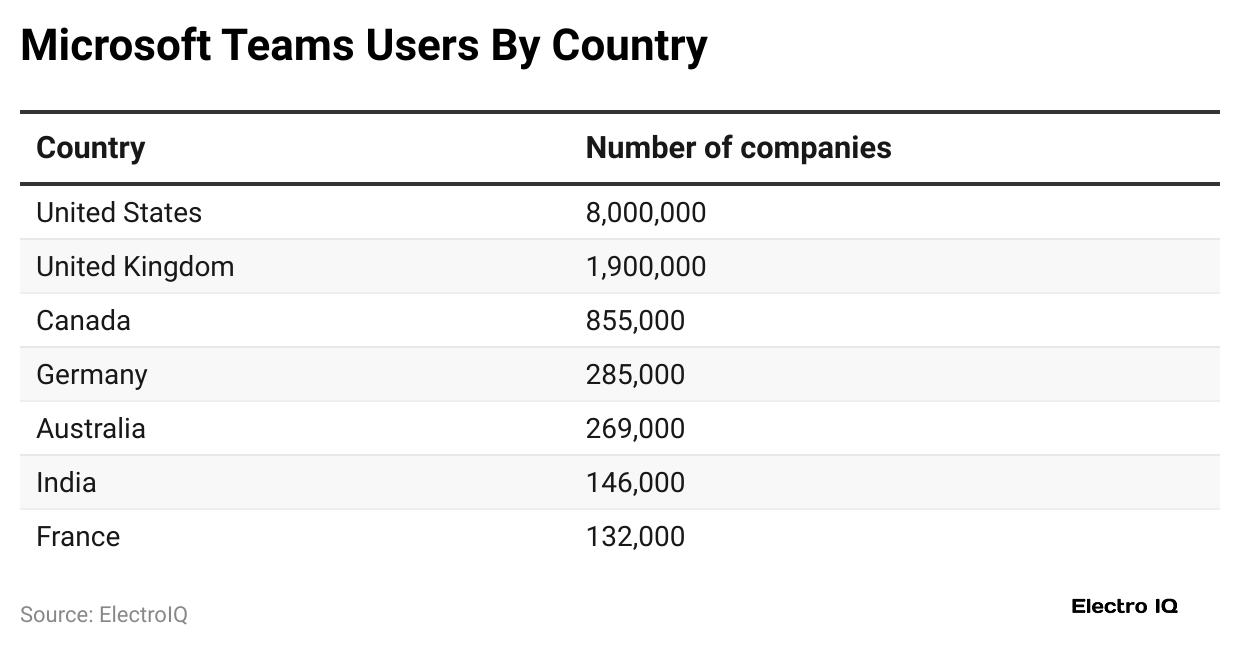 (Reference: demandsage.com)
(Reference: demandsage.com)
- Microsoft Teams is the most embraced communications and collaboration tool for companies in countries, particularly in the United States.
- It’s been estimated that around 8 million businesses in the United States are currently using Microsoft Teams. The second highest number of users for this digital platform can be found in the United Kingdom, where around 1.9 million organisations embrace Microsoft Teams.
- Canada comes next after the United Kingdom on this front, with Teams being utilised by about 855,000 companies. In Germany, figures stand at around 285,000 and in Australia, 269,000 companies have this digital platform in their operations.
- This demonstrates how the platform is widely accessed across various regions.
- According to Microsoft Teams statistics, in India, approximately 146,000 companies are making use of Microsoft Teams, while in France, users in number are close to 132,000.
- Such figures really show that Microsoft Teams is more widely embraced across the globe to increase teamwork as well as productivity.
Industries Using Microsoft Teams
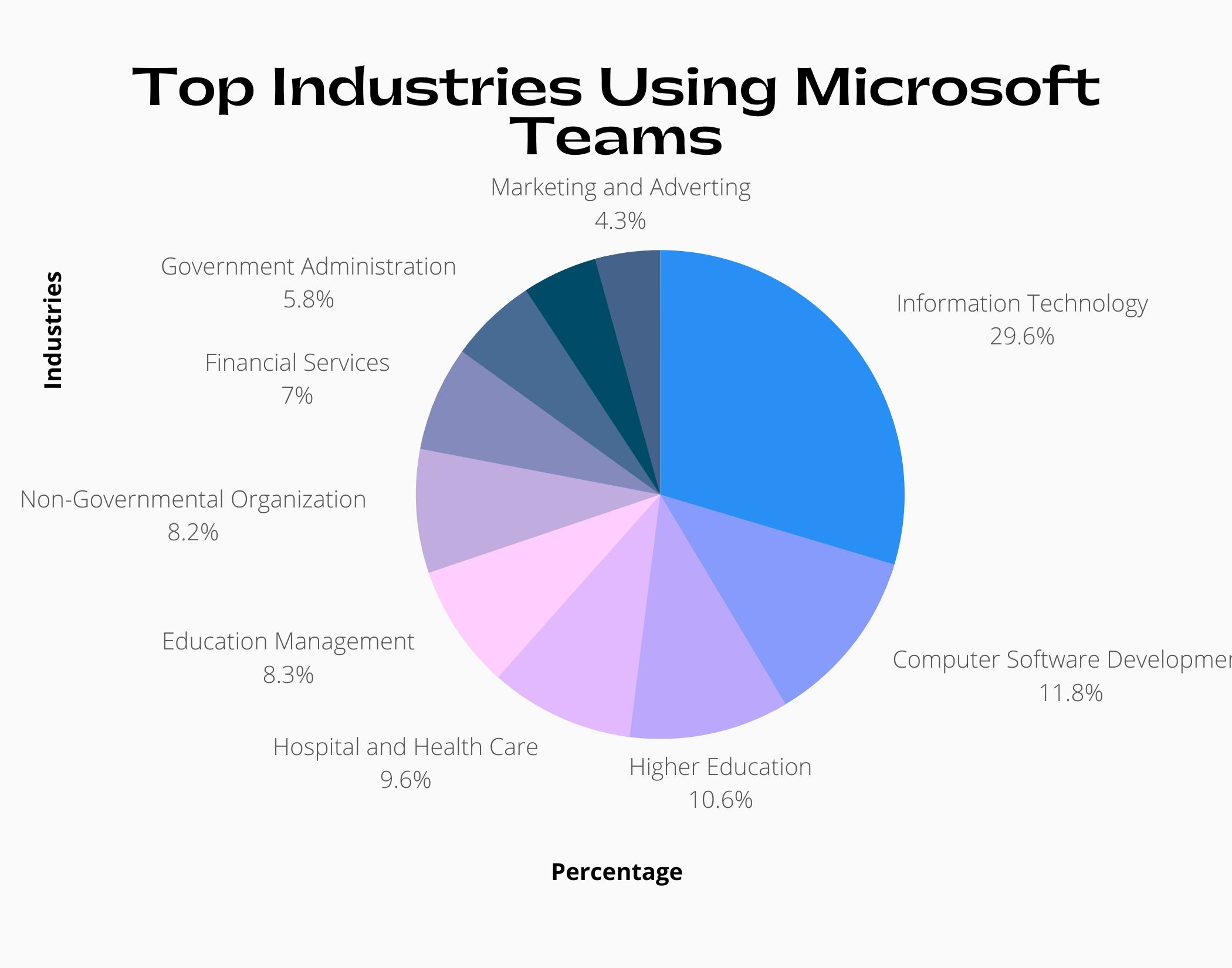 (Source: usesignhouse.com)
(Source: usesignhouse.com)
- Microsoft Teams statistics indicate that Microsoft Teams is used widely across different industries, some of which make more use of it than others. The Information Technology sector stands as the biggest user contributing to a total of 29.6% of all users.
- Computer software development comes next at 11.8%, indicative of the great dependency on Teams among tech companies for collaboration. Schools and higher-education institutions — including universities and colleges — make up 10.6% of users on the platform, while hospitals and healthcare services use 9.6% to emphasise its importance in education as well as the medical field.
- Education management (that consists of schools and administrative offices) amounts to 8.3%, and non-governmental organisations (NGOs) have 8.2%.
- Financial services embrace applications like banks and insurance companies, amounting to 7%.
- Government administration, which includes public offices and agencies, accounts for 5.8%, while marketing and advertising firms use the site at 4.3%.
- The foregoing figures show how Microsoft Teams contribute to communication and collaboration in a number of industries.
Microsoft Team User Demographics
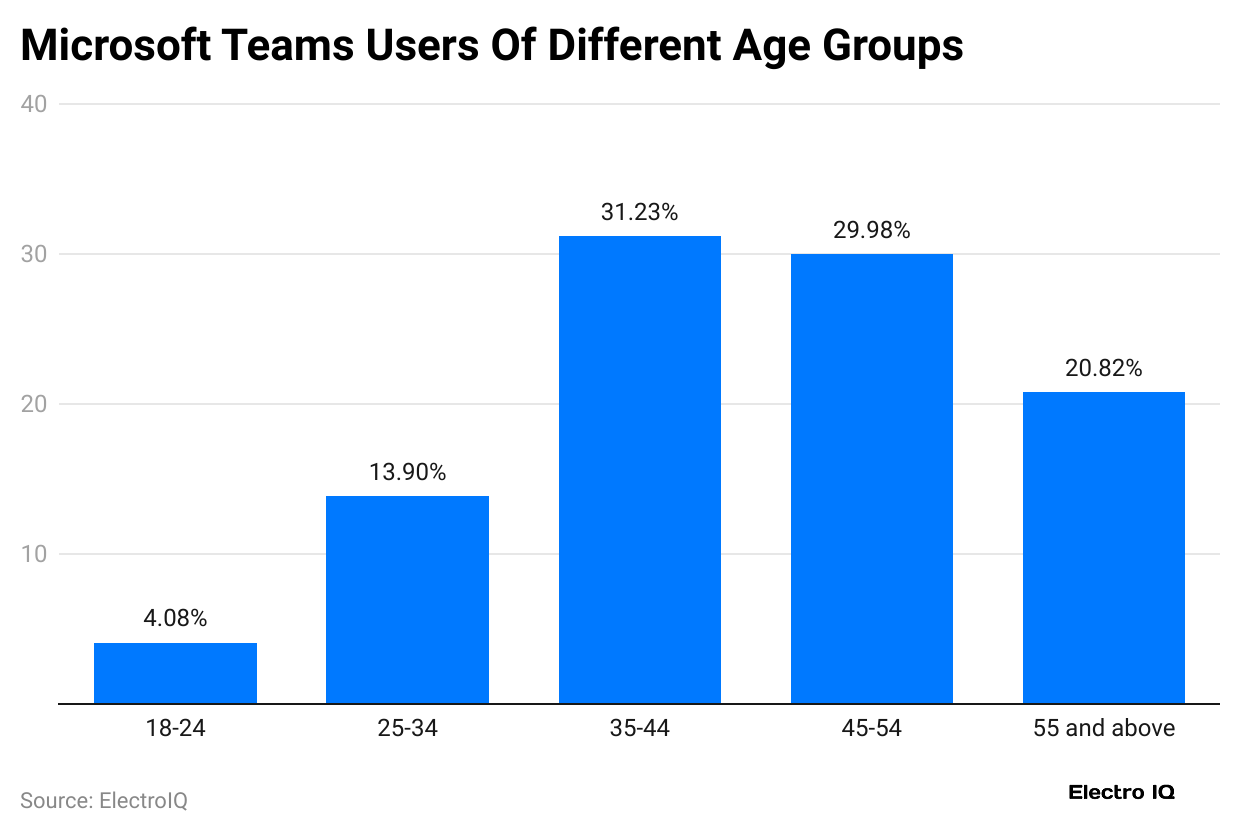
- Microsoft Teams appeals to all demographics, but every generation uses it differently. The most prominent user group is the adult population aged 35 to 44, which is currently about 31.23% of the overall users.
- In the second place, just slightly behind, are those aged 45 to 54 years, accounting for 29.98%. Young adults, or people aged 25-34 years, comprise 13.90% of the users.
- While users aged 55 and above make up 20.82% of the total Microsoft Teams users. The remaining 4.08% are made up of users aged 18-24, the youngest.
- This indicates an obvious fact that working professionals in their mid-thirties and late-fifties, who majorly use this app for business or collaborative purposes, find Microsoft Teams most useful.
Microsoft Teams Adoption Statistics
| Sectors | Adoption rate |
| Information Technology |
29.60% |
|
Computer Software |
11.80% |
| Healthcare |
9.60% |
|
Education Management |
8.30% |
| Non-Governmental Org. |
8.20% |
|
Financial Services |
7.00% |
| Government |
5.80% |
|
Marketing and Advertising |
4.30% |
- Microsoft Teams cater to a number of industries but is heavily relied upon by some select ones.
- The Information Technology sector has the best adoption rate for an almost suitable reason: 29.6% of users come from this sector. It is easy to see why when employees from IT companies work a lot on remote sites and require reliable digital tools for communication and collaboration.
- Next will come Computer Software, from which 11.8% of users use Teams. Software developers and technical people tend to work on projects requiring teamwork from different geographical locations, which is where a platform like Teams fits right in.
- Healthcare is another significant sector that makes use of Microsoft Teams, with 9.6% of adoption. Hospitals, clinics, and medical teams use the platform to coordinate patient care, communicate among staff, and disseminate important announcements.
- In Education Management, 8.3% of users depend on Teams. Schools, colleges, and universities make use of it to conduct virtual learning, hold meetings, and communicate with students and staff alike. The Non-Governmental Organization (NGO) block is reported to have 8.2% of the user base.
- Quite a handful of NGOs operate in a variety of regions globally, whereby they need some means of getting their teams in touch, managing projects, and collaborating for humanitarian purposes. Financial Services, inclusive of banks and insurance agencies, account for 7% of otal usage.
- These companies carry the use of Teams in secure communication, virtual meetings, and sharing content among employees. Government agencies make up 5.8% of Teams users.
- Many government departments use the platform for internal communication, discussions around policy formulation, and remote work.
- Finally, Marketing and Advertising stand for 4.3% of Microsoft Teams adoption. This is where those in Marketing and Advertising use it to brainstorm ideas, collaborate on campaigns, and hold virtual meetings with clients and teams.
Microsoft Teams Meeting Breakdown
| Microsoft Teams Meeting | Minutes Breakdown |
| Time Period | Meeting Minutes |
| In 1 minute | Approximately 1.875 million |
| In 1 hour | Approximately 112.5 million |
| In one day | 2.7 billion |
| In one month | Approximately 81 billion |
| In one year | Approximately 985.5 billion |
- Microsoft Teams for conducting online meetings, the time is spent by the people. As even a part, on every single minute, about 1.875 million meeting minutes are recorded. It translates to spending around 112.5 million minutes collected across Microsoft Teams users in just an hour’s time.
- This figure becomes even richer when averaged in a full day’s time: close to 2.7 billion meeting minutes.
- Over a month’s time, it totals around 81 billion minutes. Linearly extending this for an entire year brings total meeting minutes on Microsoft Teams down to nearly 985.5 billion.
- These figures speak volumes about the incorporation of Microsoft Teams communication by workplaces, schools, and organisations all over the world. For a few quick check-ins or extensive discussions, she provides billions of minutes every day of an easy and efficient means to employ remote collaboration.
Teams In Commercial, Education and Organizations
- Microsoft gives the overall generalisation of Teams users, it does not provide a specific breakdown of commercial than educational users.
- It does indicate that Teams has gained a lot of ground in the education sector. A report in February surveyed that about 100 million students have used Teams, an increase of 30 million from September 2020. With respect to this status, one major concern for Microsoft is that education licenses are far less expensive than that of corporates.
- Schools and universities do not buy expansive add-ons or upgrades, which, in turn, have affected the development of the average revenue per user (ARPU), a key metric that Microsoft CFO Amy Hood closely monitors and which also forms an interest in Wall Street analysts.
- Assuming Microsoft becomes correct in that its student count stands at 100 million, just about 45 million users toward the 145 total earlier reported would be commercial. Microsoft has not broken the numbers for obvious situations, however.
- These figures are “light” but give insight into the reality from Microsoft reports financially. They do base the possibility on FY21 Q2 data, where Microsoft disclosed that indeed, the market was taking up Teams by large organisations.
- Current data report that 117 organisations now have more than 100,000 Teams users and over 10,000 users at 2,700 organisations.
- Some big customers, such as Accenture and the U.S. Department of Veteran Affairs, have over 500,000 users each.
- However, it remains unclear if this figure comprises both commercial and education users; it is evident that Teams are huge in large enterprises.
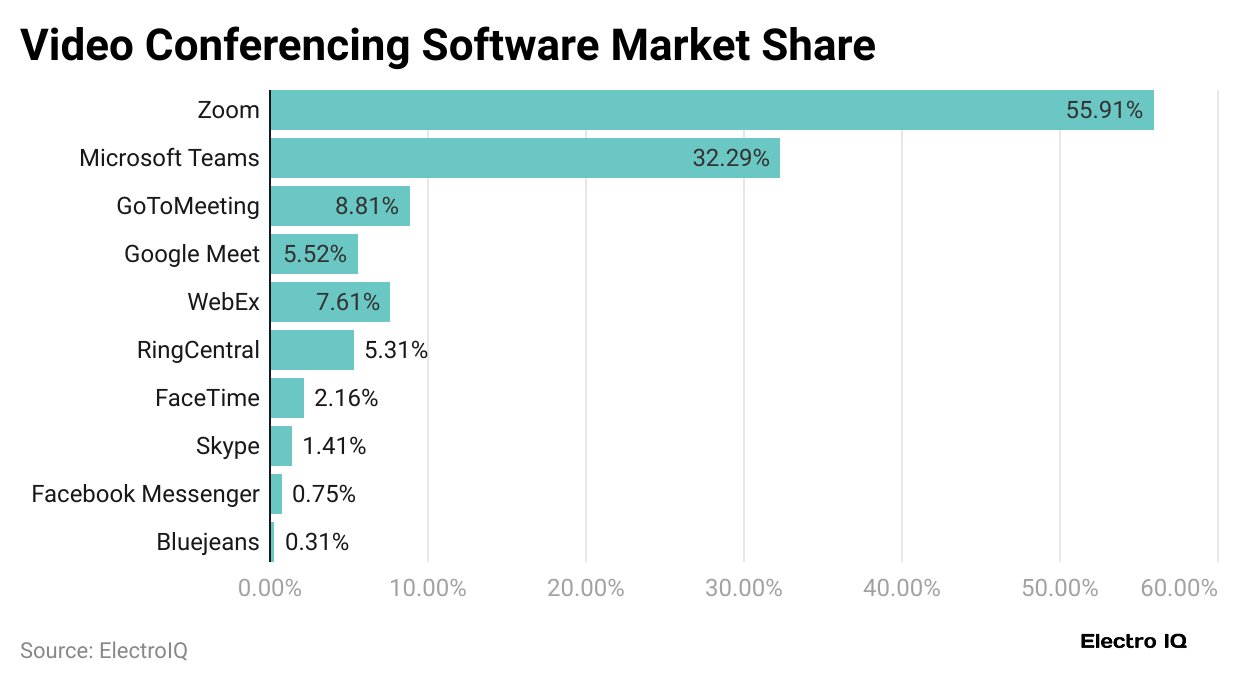 (Reference: demandsage.com)
(Reference: demandsage.com)
- At present, Zoom is the application with the largest amount of conference meetings. It is the current favourite concerning video conferencing solutions, with a market share of 55.91%.
- This implies that Zoom is the overall preferred platform for more than half of all users who resort to video conferencing solutions as they are suitable for meetings and communications through the Internet.
- Microsoft Teams is the second, with a market share of 32.29%. It has a lower proportion compared to Zoom, but it is nonetheless popular, particularly to those corporate and organisational individuals already on and in the Microsoft 365 suite for work.
- GoToMeeting has 8.81%, which is too small to measure up to that of either Zoom or Teams, but it is nevertheless popular among several companies that like holding virtual meetings via the web.
- WebEx is another conferencing platform with a market share of 7.61% and developed by Cisco. The major consumer of the product is business use within corporate environments.
- Google Meet is another video conferencing engine that has 5.52% of the market; this platform is highly used among those already using Google services like Gmail and Google Workspace.
Conclusion
As per Microsoft Teams statistics, Microsoft Teams has anthropomorphised its image as the collaboration platform of choice, illustrated by its eminent user number, excellent revenue generation capacity, and substantial market share. Widespread organisational adoption will be found in an array of
FAQ.
Microsoft Teams had approximately 320 million daily active users in 2024, with steady growth since the period of the COVID-19 pandemic.
The sector of Information Technology has the maximum share of adoption rated at 29.6%, followed by Computer Software (11.8%), Healthcare (9.6%), and Education Management (8.3%).
The growth of revenue for Microsoft Teams has been quite significant, from US$10 million in 2017 to US$8 billion in 2023, and the spike in 2020 was due to work-from-home arrangements.
The United States leads the pack with 8 million companies using Microsoft Teams, followed by the United Kingdom (1.9 million), Canada (855,000), and Germany (285,000).
Zoom With video conferencing has a basic market share of 55.91%, while Microsoft Team goes second with 32.29%, with WebEx holding 7.61% of the market and Google Meet occupying 5.52%.

Joseph D'Souza founded ElectroIQ in 2010 as a personal project to share his insights and experiences with tech gadgets. Over time, it has grown into a well-regarded tech blog, known for its in-depth technology trends, smartphone reviews and app-related statistics.










